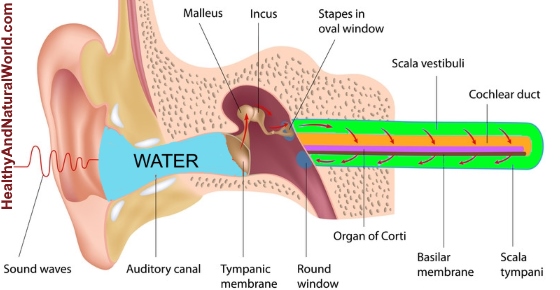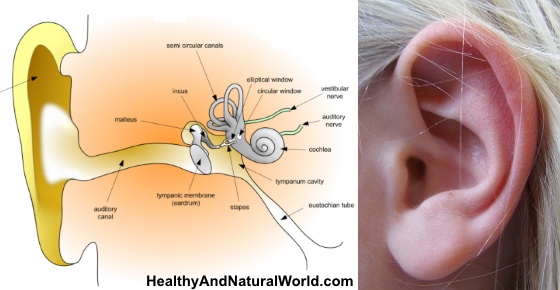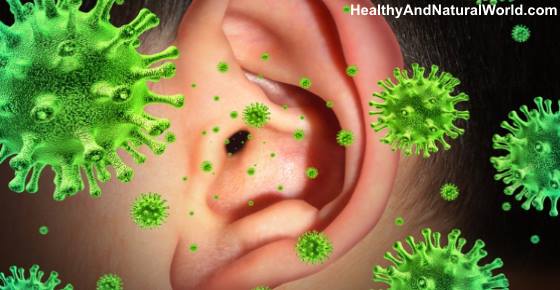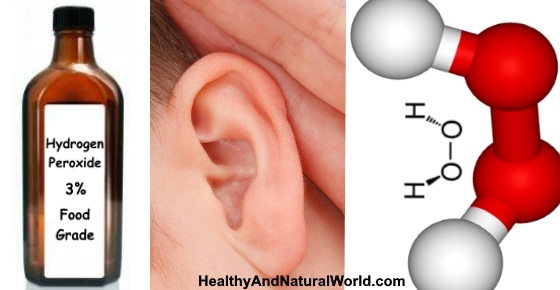Having clogged ears is an annoying condition that can cause discomfort and pain and even affect your hearing. Usually, your ears feel clogged when the ear canal gets blocked or there is an imbalance of pressure in the Eustachian tubes. Thankfully, there are effective home remedies for getting rid of clogged ears.
Clogged Ears – Overview
There are many reasons why your ears can feel plugged. For example, ear congestion can be due to a wax buildup in the ear canal, an infection in your ear, an accumulation of water, or congested sinuses. The feeling of a blockage in the ear canal could also be due to changes in air pressure, like when landing or taking off in an airplane.
This ear blockage can make your ears feel full, cause sounds to be muffled, interfere with your hearing, and even make you dizzy. Some people also have a sensation that there is water in their ear. When your ears are blocked you may also notice popping, clicking, or crackling sound in your ear.
Some of the best home remedies for clogged ears involve softening the ear wax with olive oil, using a warm compress, or applying some hydrogen peroxide. You can also relieve the feeling of a plugged ear by yawning, chewing gum, or using the Valsalva maneuver method.
Before looking at some natural ways to unclog your ears, it’s important to understand the connection between your ears and your sinuses.
Clogged Ears – The Sinus-Ear Connection
One of the most common causes of clogged ears are colds and allergies which affect your respiratory system. Your nose and ears are connected via the Eustachian tubes and infections in your nose and throat can affect your ears and cause ear and neck pain.
The Eustachian tubes keep air pressure in your ears at the right level and are usually closed but they open when we swallow, yawn or chew. These tubes help fluid to drain from the ear and help to prevent the ears from becoming infected. When you swallow, yawn or chew you can sometimes hear your ears popping as the tubes open to let air in and keep the pressure in your ears at an equal balance.
When you get a stuffy nose and congested sinuses, this also disturbs your ears and makes you less able to equalize air pressure. The result is a feeling of one or both ears being congested. The most common culprits behind plugged ears are viral infections, bacterial infections, and allergies. However, people with Eustachian tubes that are too narrow can also feel that their ears are constantly full.
Natural Ways for Getting Rid of Clogged Ears
How to prevent clogged ears due to sudden pressure changes
The best way to prevent the feeling that your ears are plugged due to sudden pressure changes is to keep the pressure in your ears equal. So, if you are planning to fly or drive up and down mountains, here are some tips to equalize the pressure in your ears:
This will open up your Eustachian tubes and relieve stuffiness and pain in the ear by normalizing the pressure in your ears.
There are other natural ways to deal with any sudden change in pressure around the eardrum – read about them in my article about the best natural ways to unpop your ears.
Valsalva maneuver
A great way to get rid of the feeling of a clogged ear and to relieve pressure is to use the Valsalva maneuver. You can do this anytime and anywhere and it is effective in equalizing the pressure in your middle ear. The Valsalva maneuver involves gently breathing out while your nose and mouth are closed to relieve the sensation of fullness in the ears. To unclog your ear using the Valsalva maneuver, do the following:
- Pinch your nose tight to close the nostrils and keep your mouth closed.
- Breathe out as if trying to exhale through a closed nose. Don’t do this too forcefully as you might hurt your eardrum. There should be no pain involved.
- You might hear a popping sound, which means the pressure has been relieved.
The Valsalva maneuver method is also one of the best ways of relieving pressure from your ear caused by water in the ear.
Adopt a good sleeping position
Adopting a good sleeping position can also help ease ear congestion by allowing fluid to drain easier from the ears. Many health conditions deteriorate overnight and we wake up feeling groggy and run down. To help prevent your ears becoming congested while you are sleeping, you can do the following:
- If you sleep on your back, use a few pillows to prop your head up and sleep in a semi-upright position. This will help the ear canals to drain properly to prevent clogged ears.
- Some people find relief from blocked up ears by lying on their side. Lay down for about an hour with the congested ear facing down. This can help to reduce pressure and enable your ears to unclog easier.
If you have trouble falling asleep, use this special technique to fall asleep in less than 1 minute.
Other Natural Remedies to Treat Clogged & Stuffy Ears
You may have congested ears because of an infection or sinus pressure in your ears. In that case, there are many natural remedies that can help to loosen mucus in your nasal passages, clear ear wax, and drain fluid from the ear canal.
1. Warm compress
Placing a warm compress on the blocked ear is a great natural way to help relieve a clogged ear caused by a cold or an ear infection. The heat from the compress helps to loosen the blockage and soothe the pain and discomfort.
How to do it
- Soak a clean washcloth in warm water and wring it out.
- Place it over the blocked ear for 10 minutes to allow the heat to unblock the congestion.
- Alternatively, you can also wrap a hot water bottle in a towel and place it over the painful ear to relieve the pain and pressure in the ear.
2. Saline nasal rinse
Another great way to unclog a plugged ear is to rinse your nasal passages with a saline water. Salt is a well-known antibacterial agent and it can help to rinse your sinuses, kill infections, and reduce inflammation in your nasal passages. Washing your nasal passages can relieve the feeling of congestion by removing and softening mucus which is blocking the Eustachian tubes.
The easiest way to rinse your nasal passages is to use a neti pot. Dr. Luqman Seidu on WebMD says that a neti pot helps to clear the nasal passages. It’s an effective home remedy to get relief from a sinus blockage or allergy symptoms.1
You can also use a bottle called NeliMed Sinus Rinse (like this one) to rinse your sinuses. The bottle uses the same principal of a neti pot but it is much easier to use.
Please read my article on the best home remedies for a sinus infection for detailed instructions on how to do a saline rinse to clear your sinuses and relieve congested ears.
3. Gargling warm salt water
Gargle with a warm salt water is another home remedy to get relief from a congested ear caused by an ear infection. Surprising as it may seem, gargling a saline solution to treat a throat infection can actually help clear your ears.
Dr. Dan Brennan on WebMD says that the salt water helps to soothe a sore throat and actually helps to unblock the Eustachian tubes.2
Here is how to use a salt water gargle to get rid of clogged ears and relieve the symptoms of a sore throat:
- Mix one teaspoon of salt in a cup of warm water.
- Swish it around your mouth and gargle for 15 to 20 seconds.
- Spit it out.
- Repeat as often as possible until you feel that your ears are no longer clogged.
Gargling with salt and water is also one of the best home remedies for chest congestion and it is also an effective remedy for clearing throat mucus.
4. Tea tree oil combined with steam inhalations
If a cold is causing your ears to feel clogged, use a tea tree inhalation to get rid of the infection quickly to relieve the congestion. Combining tea tree oil with a simple steam inhalation technique can naturally relieve blocked ears, cure congestion, sore throat, chest infections, and clear up mucus.
Tea tree oil has amazing healing properties which can help to treat viral and bacterial infections in the respiratory system. You can read about the 75 extraordinary uses for tea tree oil.
The journal Clinical Microbiology Reviews reported that tea tree oil contains powerful natural compounds called terpenoids. These have been proven to have an antimicrobial effect against various infection-causing pathogens. For example, tea tree oil can effectively kill off the Streptococcus pyogenes strain of bacteria which is responsible for strep throat.3
How to do it
- Pour boiling water in a bowl.
- Add a few drops of tea tree essential oil – you can also use lavender or eucalyptus oils.
- Inhale the steam, but be careful not to get burnt. The steam can also help thin and loosen the mucus in your nasal passages, which in turn will give you relief from clogged ears.
Use the tea tree oil inhalation regularly to get rid of clogged ears that are due to a cold, the flu, or a sinus infection.
5. Garlic oil
Another natural antibacterial remedy for unclogging ears is garlic oil. The warm garlic oil can help to loosen the congestion in your ear and the garlic properties can destroy any infection-causing germs.
A study published in the journal Microbes and Infection found that garlic contains a compound called allicin. This natural antibiotic and antibacterial agent can be used as a natural remedy for treating various infections. It is powerful enough to also kill off antibacterial-resistant strains of infections.4
To make your own garlic oil to unclog your ears naturally, this is what you should do:
- Mash two cloves of garlic and let them stand for 10 minutes to allow the allicin to form.
- Put the crushed garlic in a saucepan with 5 tablespoons of olive oil.
- Warm for 10-15 minutes over very low heat to let the beneficial properties of the garlic infuse into the oil.
- Let it cool down to skin temperature and then put it in your ear for 1 minute to help loosen any blockage or wax that is causing your ears to feel full. The warmth and the oil often offers fast pain relief as well.
- Drain the oil out.
If you prefer not to heat garlic, you can mince the raw garlic and keep it in olive oil without heating for 2-3 hours before straining and using.
To increase the efficacy you can add to the olive oil garlic and mullein flowers that work very well for relieving ear infections. Mullein has been used in traditional medical systems due to its anti-inflammatory and antiseptic properties.
Garlic Mullein Oil to Treat Ear Infection
2-3 tbsp chopped garlic
2-3 tbsp mullein flowers
Extra virgin olive oil
Place the garlic and mullein flowers in a small saucepan and add just enough oil to cover the herbs. Warm for 15-20 minutes over very low heat. Strain well and store in tightly covered glass jar in the refrigerator.
How to use? warm the oil in a teaspoon over a candle or stove-top burner. Warm only to body temperature (about room temperature). Use a dropper and apply 3-4 drops into the ear. Apply the warm oil every 30 minutes or as often as needed.
Ear Wax Removal
If your ears are clogged due to wax accumulation, there are many easy ways to get rid of it naturally and safely to relieve the blockage. Be very careful when cleaning inside your ears especially when using cotton swabs or Q-tips as there are many good reasons not to stick anything inside your ear.
One word of warning: do not use any of these treatments if you have a hole in your eardrum.
Here are some of the best home remedies to remove ear wax.
1. Olive oil
To get rid of the wax that is clogging your ears, use warm olive oil. The soothing properties of olive oil will remove any discomfort from your ear and help the wax to drain quickly and clear the blocked ear.
Here is how to do it
- Warm some extra-virgin olive oil.
- Put a few drops in the blocked ear using a dropper.
- Keep your head sideways to help the oil settle.
- Let the oil go to work for a few minutes to soften the ear wax.
- Using a cotton bud, gently and carefully remove the loosened wax from the outer part of the ear.
- Use the remedy as often as necessary to get rid of all the excess wax from your ears.
2. Apple cider vinegar (ACV) and alcohol
Apple cider vinegar has amazing health benefits and using it together with rubbing alcohol is a great way to unclog ears naturally. The ACV mixture also has antibacterial properties that can help to reduce any ear infection that is causing clogged ears. The low pH content of ACV also helps to reduce any itching in and around your ear canal.
Pediatrician Dr. David Hill says that this concoction will soften the troublesome ear wax, allowing it to flow out of the ear more easily.
To use apple cider vinegar and alcohol to remove excess wax from your ears, this is what you should do:
- Mix equal amounts of ACV and rubbing alcohol.
- Put a few drops of this solution in your ear.
- Keep your head sideways, so the ear wax remedy stays in.
- You can also put a piece of cotton ball over your ear to prevent the fluid from dripping out.
- Let it work for 10 minutes to soften the wax buildup.
- Remove the wax carefully from the outer part of your ear with a cotton bud.
You can repeat this remedy 2-3 times if you have a large blockage of ear wax.
3. Food Grade Hydrogen peroxide
Food grade hydrogen peroxide can help you get rid of a buildup of ear wax quickly and effectively which can help you to unplug your ear. Hydrogen peroxide has an antiseptic effect that can help to prevent skin infections. According to doctors at WebMD, the bubbling action helps to bring up dirt and loosen it.5
Researchers from Harvard Medical School recommend using 3% hydrogen peroxidefor ear wax removal.6
If you want to get rid of a congested ear using hydrogen peroxide, this is what you should do:
- Put two drops of 3% food grade hydrogen peroxide in your clogged ear. Don’t exceed that amount or you could damage your eardrum.
- Wait until you hear a fizzing sound (it should take a few minutes).
- Let it fizz for few minutes until it stops.
- Tilt your head to the side, so that the solution and ear wax can drip out.
Do this every time you need to unclog your ears from excess ear wax.
Hydrogen peroxide can also treat ear infections due to its antiseptic properties, and you can read more about in my article on how to use hydrogen peroxide for an ear infection.
For more ideas on how to use hydrogen peroxide – read my post about 11 amazing uses for hydrogen peroxide.
Some More Tips for Unplugging Your Ears
Sometimes, making a few changes around your home and making some different lifestyle choices can do much to prevent your ears becoming clogged. Here are some of my best tips for unplugging your ears naturally.
Use a humidifier in your bedroom. This will provide your sinuses with the much-needed moisture and might relieve the pressure that is in your Eustachian tubes.
To alleviate the pain of plugged ears, sit in the bathroom with a hot shower running. The steam helps clear the ear canals and prevents them from drying out. Dry ears can make the body over-produce ear wax which can lead to a buildup of excess wax in your ear canals.
If you suffer from an ear infection, read my post about the best home remedies for getting rid of ear infection.
Sinus-related problems can be made worse by temperature extremes. If you feel your nose and ears are playing up, skip the morning jog on a freezing day. If you have a sinus infection read my post about the best ways to treat sinus infections naturally.
Avoid sudden changes in body position (this can cause dizziness) and keep your head up. Don’t shake your head or stand up fast.
Drink plenty of fluids to thin the mucus in the nasal passages and prevent ear congestion. Avoid alcohol, too much tea and coffee, tobacco, and overly salty foods. They can affect your blood circulation and further worsen the condition of your ears.




